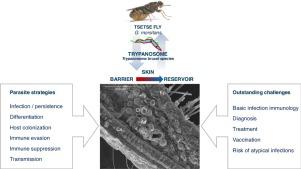当前位置:
X-MOL 学术
›
Curr. Opin. Immunol.
›
论文详情
Our official English website, www.x-mol.net, welcomes your feedback! (Note: you will need to create a separate account there.)
Inflammation following trypanosome infection and persistence in the skin.
Current Opinion in Immunology ( IF 7 ) Pub Date : 2020-05-20 , DOI: 10.1016/j.coi.2020.04.006 Dorien Mabille 1 , Guy Caljon 1
Current Opinion in Immunology ( IF 7 ) Pub Date : 2020-05-20 , DOI: 10.1016/j.coi.2020.04.006 Dorien Mabille 1 , Guy Caljon 1
Affiliation

|
Human African trypanosomes rely for their transmission on tsetse flies (Glossina sp.) that inoculate parasites into the skin during blood feeding. The absence of a protective vaccine, limited knowledge about the infection immunology, and the existence of asymptomatic carriers sustaining transmission are major outstanding challenges towards elimination. All these relate to the skin where (i) parasites persist and transmit to tsetse flies and (ii) a successful vaccination strategy should ideally be effective. Host immune processes and parasite strategies that underlie early infection and skin tropism are essential aspects to comprehend the transmission-success of trypanosomes and the failure in vaccine development. Recent insights into the early infection establishment may pave the way to novel strategies aimed at blocking transmission.
中文翻译:

锥虫感染后的炎症和皮肤持续存在。
非洲人类锥虫依靠采采蝇 (Glossina sp.) 进行传播,采采蝇在采血过程中将寄生虫接种到皮肤中。缺乏保护性疫苗、对感染免疫学的了解有限以及存在持续传播的无症状携带者是消除的主要突出挑战。所有这些都与 (i) 寄生虫持续存在并传播给采采蝇的皮肤有关,以及 (ii) 成功的疫苗接种策略在理想情况下应该是有效的。早期感染和皮肤趋向性的宿主免疫过程和寄生虫策略是理解锥虫的传播成功和疫苗开发失败的重要方面。最近对早期感染建立的见解可能为旨在阻止传播的新策略铺平道路。
更新日期:2020-05-20
中文翻译:

锥虫感染后的炎症和皮肤持续存在。
非洲人类锥虫依靠采采蝇 (Glossina sp.) 进行传播,采采蝇在采血过程中将寄生虫接种到皮肤中。缺乏保护性疫苗、对感染免疫学的了解有限以及存在持续传播的无症状携带者是消除的主要突出挑战。所有这些都与 (i) 寄生虫持续存在并传播给采采蝇的皮肤有关,以及 (ii) 成功的疫苗接种策略在理想情况下应该是有效的。早期感染和皮肤趋向性的宿主免疫过程和寄生虫策略是理解锥虫的传播成功和疫苗开发失败的重要方面。最近对早期感染建立的见解可能为旨在阻止传播的新策略铺平道路。



























 京公网安备 11010802027423号
京公网安备 11010802027423号